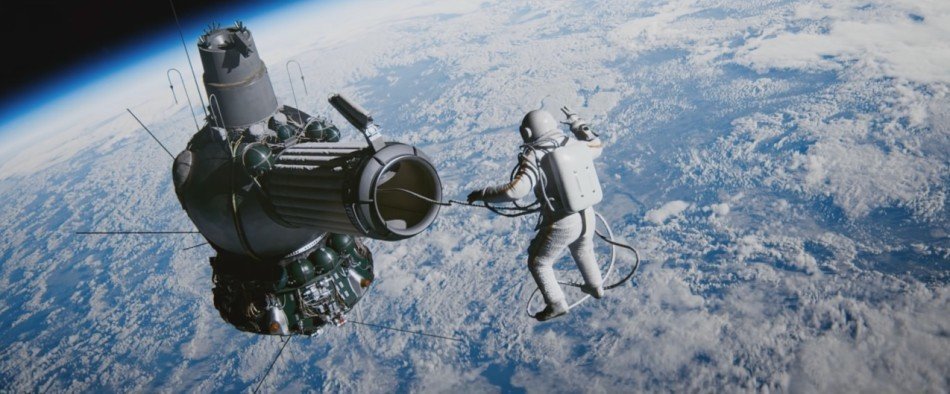
Shot from the second official trailer of the film “Time of the First”
On the origin of the facts
The main adviser to the film was personally Alexei Leonov, whose flight is the subject of the picture. His credibility is enormous, and the fact that he approved the film literally makes you think that everything was literally as it is shown on the screen. But we need to understand that the film is still artistic, and it can have both random errors and a change in real events to please the vision of the screenwriter and director. Fortunately, the flight of “Voskhod-2” was well described in two very authoritative sources – the memoirs of “The Rockets and People” by Boris Evtosevich Chertok, who was directly subordinate to S.P. The queen also dealt with control systems, and the diaries of General Nikolai Petrovich Kamanin, who directed the selection and training of Soviet cosmonauts. Both of them, by the way, are shown in the film.
The problem of excessive dramatization
Probably, because now the cinema should be very dynamic, those who make films, there is a temptation to embellish reality, reducing time, reducing the distance or increasing the speed of real events. For example, in military dramas, there are often more opponents than in reality, and they are firing from a shorter distance. And not always this “concentration” of the film looks good. For example, in the film “Gagarin: The First in Space”, the rocket starts, like an atomic explosion, so brightly that the characters literally crook from blinding light. It is clear that I want to show how impressive is the launch of the rocket, but still it’s too much. “The time of the first”, alas, did not escape the same desire to push the pedal to the stop.
At the very beginning of the film, an airplane crash, piloted by Leonov, is shown. And then it starts – if the dive, then steep, if the way out of the dive – then in centimeters from the ground. The saddest thing is that this story may well have taken place in reality – jet engine engines really need to be untwisted with an oncoming stream for launching in the air, only the dive would be quite sloping. And then there would not be a glaring unreality of landing – an attempt to sit down as on the screen would end up tearing off the chassis when they were released at an unacceptably high speed and a catastrophe. And the tension would have been preserved if the emphasis on how Leonov was trying to reach the band, perebaryvaya technique.
Next, the pedal is also not released – if the oxygen ends, then it will end at the very last moment, if rescued – Then seeing the last signal rocket on the last remains of fuel, which magically ceases to end as soon as the cosmonauts were noticed. Against the backdrop of a true drama of what was in reality, it looks somehow frivolous and far-fetched.
What did you now quote?
It is difficult to shoot an original movie. Bright movies that have become the first or extremely successful in some area, often generate stamps, which are then used in other paintings. The whole question is in relevance. “Time of the First” clearly cites “Gravitation”, “Gagarin: The First in Space” (or even “Gladiator”), “Apollo 13”. And personally, in my opinion, the quotes are not quite in order – you have time to figure out what you just quoted, and you understand that in principle this was not necessary, because quotes rather distort real events, and without them you could get along.
This wonderful technique
But the technique and display of her work on the screen turned out to be at the highest level and I liked the most. The winter launch of the rocket is more beautiful than the summer, and thanks to computer graphics we see the events as no real camera will show.

Branch of the side blocks, frame from the third official trailer
Against the backdrop of such beauty, realistic surveys of the on-board camera look paler. And in the film, the work of steering engines and aerodynamic rudders of the first stage is perfectly illustrated, the airlock is inflated and discharged, and the reserve braking engine is reset. Even block I (the third stage) was twisted to the right side after removal, although they did not show it very clearly. The work with the device “Vzor”, on which the correct orientation for braking is constructed, is visually shown. The work of the parachute system, which in layout with two parachutes and a soft landing engine over the ship, was only very good for the “Voskhods”.
At the same time, of course, there were some minor technical mistakes.
]
First, the last command to launch a rocket is given by turning one mechanical key – the so-called “The key to start.” The words “Preliminary”, “Intermediate”, “Home”, “Lifting” (it was not in the film) indicate the stages of increasing the thrust of the engines and are performed independently by the rocket. Switching tumblers, as in the movie, no, and the person who says these words, simply notifies those who do not see the indicators on his console. The operations for launching the R-7 missiles as a whole have not changed, and now they turn the same key and say the same words. Here is a video of the real start, at 9:57 am with the key to start screwing the safety cover.
Second , For some reason, the incidents that were not in this flight were quoted. When braking the ship does not detach the aggregate compartment, which was in the real flight of Gagarin, but problems with the separation of the compartments at Voskhod-2 are not mentioned either by Kamanin or, more importantly, by Chertok, and the electrician was his work profile. Further, Kirillov (the announcer) in the recording of the report on the death of astronauts actually retells the Komarov catastrophe on the Soyuz-1, which is not very appropriate.
Thirdly, Leonov blew the atmosphere in the suit not at random – the designers envisaged the possibility of reducing Pressure from 0.4 atmosphere to 0.27. The main risk was in the caisson disease – if there were nitrogen in Leonov’s blood, he could boil and block the normal flow of blood through the vessels. But the astronauts by that time had been breathing pure oxygen for about an hour, and nitrogen from the blood had disappeared. Unfortunately, this is not explained in any way in the film, and against the backdrop of the fact that Leonov is shown by a faker ignoring the rules, he looks worse than he could.
Fourthly, for some reason, instead of the correct name for the commands of the landing cycle – “Descent-1”, “Descent-2” and “Descent-3” use the expression “Cycle-4”. Indicators of the stages of descent can even be seen in the close-up of the cabin.
Fifth, the accident of the hatch closing system is not confirmed by other sources, but, apparently, was invented for greater dramaticness and not to explain that it is necessary to unfold even in the case of a normal automatic Closure of the hatch, because the ship still needs to step forward (there is a trivial lack of space).
Sixth, the accident of an unmanned training ship is too dramatic. In reality, “Kosmos-57” received two identical teams from two different ground stations, which, overlapping each other, formed a team to descend. And the system of emergency detonation, having determined that the ship sits not in the territory of the USSR, blew it up. This story is interesting in its own way, and it’s a pity that in the film it was not told. Further, the process of landing the ship with the “collar”, which remains after the release of the lock, had time to check on the unmanned photodetecting device, which landed quite normally. So the risk was less than that shown in the film, and engineers and designers knew more.
In the seventh, the film is constantly shown by antennas of distant space communications. They certainly look impressive, but they are off-screen in the shot, and in reality the connection with the astronauts and the reception of the TV signal were led by these modest but beautiful four-spiral antennas
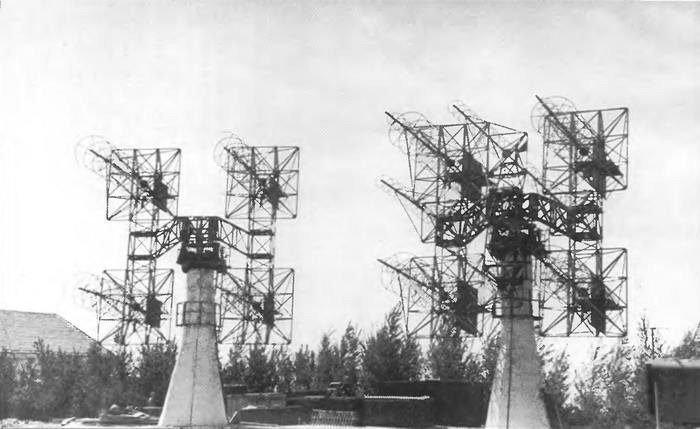
Telemetry antennas “Tral” and space television “Yastreb” and “Topaz-25”, photo KIK USSR
But the rotation of the ship after the release of the lock was in reality and almost literally described in the diaries of Kamanin . Indeed, he did not stop, saving a supply of compressed gas in the orientation system. In the film, he, alas, is called “fuel”, which is incorrect, and this scene could be filed more clearly. The increased gas consumption was due to the fact that for Leonov’s exit into outer space, the ship had to maintain an unchanged position in space. Alas, the film does not explain it in any way.
Entertaining physics
With physics in the film, things are also not very smooth.
First of all, it’s very funny to watch training in an airplane. On the one hand, the parabola at which artificial weightlessness is obtained is shown quite reliably, on the other hand, the maximum duration of such weightlessness is about 30 seconds, and it is physically impossible to complete all operations in one session. The race for the time is shown well, but, alas, it is not realistic.
A very offensive blunder is probably taken from the attempt to quote Apollo 13. The MCC is talking about the fact that if the orientation is wrong, the ship will jump off the atmosphere and will hang out in space for a long time. This is physically impossible – for the ships “Vostok” and “Voskhod” the descent device is spherical, and does not create any lifting force. If you enter the atmosphere, then everything, braking and landing. Further, even if such a lifting force were, then from a low circular orbit, it would be possible to jump on it for minutes and hours, but not days, as in the film. But on the trajectory of the return from the Moon, indeed, the energy reserve is such that incorrect actions can send the ship back into space for a very long time. At the same time, the danger with wrong orientation was – if the astronauts were oriented backwards, then they would spend fuel on the orbital ascent. And even then there was the last chance – a spare solid-fuel engine that is located above the sphere of the descent vehicle.
In the episode with the return to the ship, Leonov is flying too much in the style of “Gravitation” with improbably high speed around the ship. Most likely because of the concentration of drama, the velocities and impulses were increased several times.
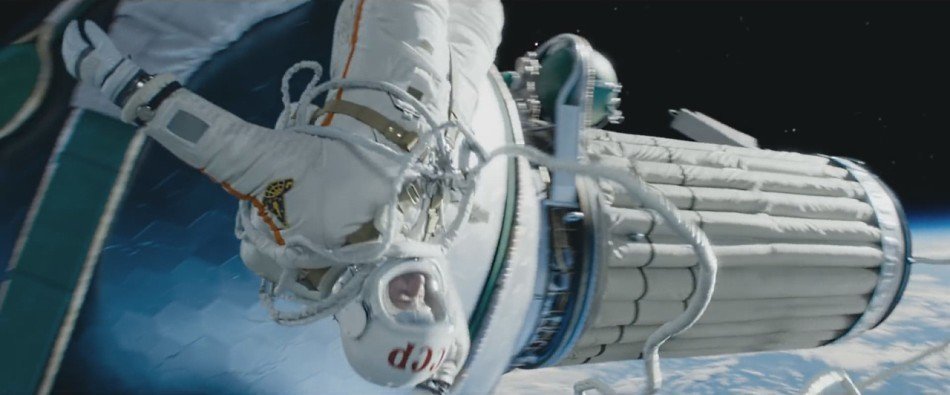
That’s exactly what certainly was not. A shot from the third official trailer
At the same time in reality it was a huge problem to go back in reality, it’s a well-known fact. It is also known that Leonov did not report on his problems to the ground, but a complete radio silence with loss and visual visibility, from which everyone is nervous – again unnecessary dramatization.
And finally, the braking scene shows that the ballistics creators The film is not understood very much. In reality, indeed, the braking motor did not start on the 17th turn because of the failure of the solar orientation system. But the connection with the ground was, and the cosmonauts were recommended to sit manually on the 18th or 22th turn. The cosmonauts trained in the case of a manual landing and had appropriate instruments. Therefore, talk about the heroic death in orbit – insulting nonsense.
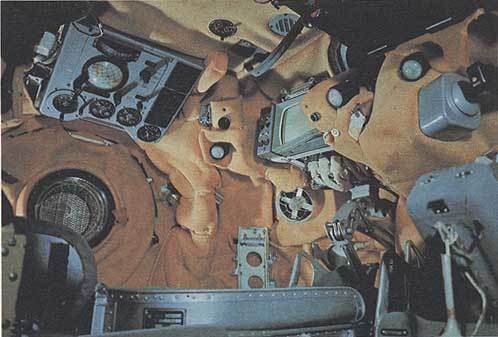
“Voskhod-2” cockpit, a photo from K.Gatland’s book “Space technology”, incorrectly attributed to the cabin “Sunrise” -1 “
In the photo above the round porthole on the left is the” Eye “for building the landing orientation. If the ship is oriented correctly, the ground runs upward, and on the periphery of the device an even horizon line. Above the “Eye” is the instrument panel on which the globe is visible. This globe can show the current position of the vehicle and the point at which the ship sits, if you turn on the braking motor at this second. Despite the fact that the globe is small, it is possible to aim with accuracy, with an error of tens, but not thousands of kilometers.
Another very important thing is missed in the film – you have to slow down at the right time. You can not sit and think like this. In reality, according to Leonov’s recollections, they really could not properly orient the ship, being in lodgmentals, and Belyaev steered, getting out of the lodge and laying down across Leonov. Because of this they were forced to again occupy the original places and started the engine not immediately, but in principle they sat down about where they were going. This could be shown as a dramatic moment, but with maximum realism the accents would be different.
Drama with oxygen
This episode begins with a clear attempt to quote “Apollo 13”, when the freezing water breaks the body, not something in the ship’s electrical system. But if a real accident is shown in the Apollo, then the reason is invented. Leonov himself as the reason for air leakage from the cabin in an interview called the uneven heating of the ship and the skew of the hatch because of this. Kamanin and Chertok do mention that the pressure in the system of pressurization of oxygen dropped from 75 to 25 atmospheres, and this actually was a state of emergency. But in real history, after the meeting at the command post, it was decided not to do anything – the pressure drop stopped, and the oxygen supply was sufficient until a regular landing on the 17th turn. So the idea again to quote “Apollo 13” with the panel cutting, almost arranged short circuit and pulling the sensor unconscious turned out so-so. My main complaint here – instead of showing really teamwork on finding and eliminating problems, we are pictured the miraculous rescue of the crew from the deadly danger. I have already said repeatedly that for some reason films and books on real accidents are more interesting than imaginary ones. And the drama could be well served also in case the astronauts sat, waited and did nothing.
Search and rescue
Probably, my biggest claim to the film is after the landing. From what is happening on the screen it seems that the search and rescue system of cosmonauts in the USSR is no good, and Belyaeva and Leonov are saving a miracle again. Moreover, in reality there was a story in its own way very interesting. Indeed, Voskhod-2 landed in a dense forest north of Perm. But in the USSR there was a system of direction finders and radars for control of outer space, which saw the reduction of the ship and tracked its radio beacons. The location of the ship was known to within 50-70 km. But the search planes were deployed in 600-800 kilometers from the landing site, and could not reach right away. In Alma-Ata, the signal of cosmonauts “VN” (everything is normal) was taken on short waves, so at the command post they knew that the ship had landed, and the cosmonauts were almost certainly in order. Belyaev and Leonov were really alone for a while, but after four hours they saw a helicopter and reported:
Between the villages of Soroca and Shchuchino in the forest we see a red parachute and two cosmonauts. The astronauts are sitting and having dinner. The ship landed in a dense forest, far from populated areas. Around the deep snow.
Alas, because of excessive dramatization in the film, they try to tell a very different story. But just when the scene ends in the cinema with the discovery of astronauts, in reality the most interesting begins. The fact is that no one could get to Belyaev and Leonov – a helicopter with rescuers did not find a landing near the landing site, and the soldiers of the air defense regiment that had appeared on the truck also failed to reach the astronauts quickly. As a result, Belyaev and Leonov had to spend the night alone. The next morning the situation also did not look as dramatic as in the film:
I see two at the ship, one chop wood, another put them in the fire, both are dressed in flight uniform.
As a result, before “Sunrise” -2 “rescuers were able to get only at 11:35 am the second day. But the astronauts did not dare to evacuate the helicopter by rope ladder, and began to cut down the landing pad for him. The cosmonauts spent the night in the forest. This was not a special discomfort, they even cut down the hut for them, and there was no problem with the supply. But only on the morning of the third day on skis Belyaev and Leonov were finally evacuated from the landing site. And the Soviet media wrote that all this time they were vacationing at the country committee of the regional party committee:)
A separate sad story with an episode about a radio amateur from Sakhalin. Theoretically, he really could hear “Voskhod-2” for thousands of kilometers – the reflection of radio waves from the ionosphere on short waves allows this. But then the unpleasant story in the style of “bloody gabni” begins. Given that the consequences for the radio amateur in the film are not shown, if you want, you might think that he was still imprisoned, and this does not combine with the heroic and patriotic pathos of the film. It is doubly insulting to look at this story for those who saw the funny Soviet film “The Alien Ship” and had already joked about the local “meteorologist Mangulov.”
History with the MCC
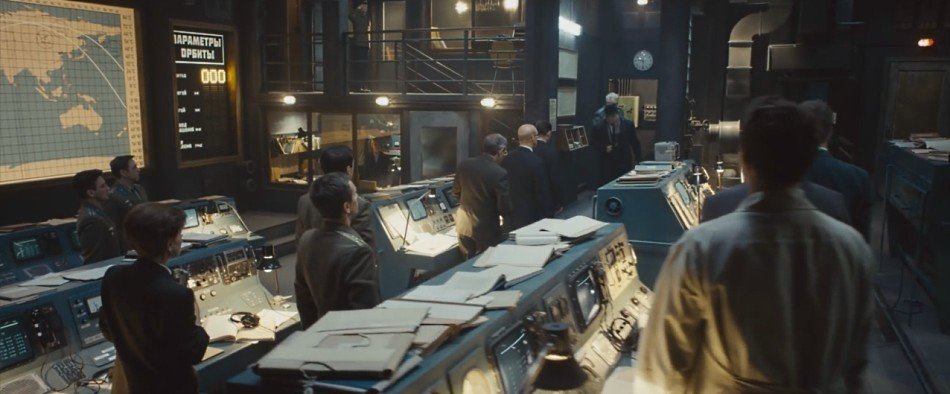
Кадр из второго официального трейлера
Отдельная интересная история с Центром управления полетами, как он показан в фильме. Увы, но красивая картинка выше представляет собой копию американского ЦУПа. В реальности в советской космонавтике красивый зал ЦУПа сделали только к полету «Союз-Аполлон». Во время совместной миссии центр управления полетами не мог быть секретным, поэтому специально сделали большой и красивый зал с лучшим на то время оборудованием, чтобы было что показать. А до этого полетами вполне успешно управляли по несколько другой идеологии. В СССР основой был измерительный пункт ИП-1 на Байконуре, и старт ракеты фиксировался вот в таких кунгах телеметрической системы «Трал».
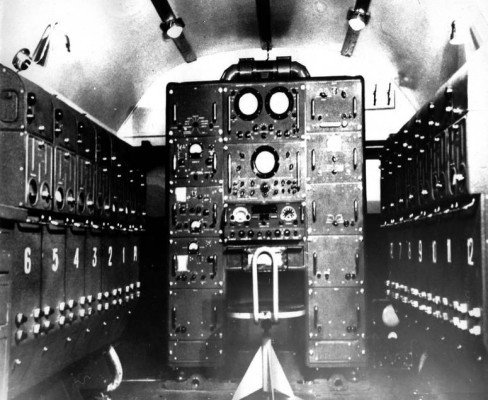
Кунг системы «Трал», фото сайта КИК СССР
А сам ИП-1 представлял из себя комплекс зданий, машин и антенн. Кроме этого, около стартового стола расположен бункер, с которого непосредственно управляют пуском ракеты. И Королев, Черток, Каманин и прочие в момент полета находились на Байконуре.
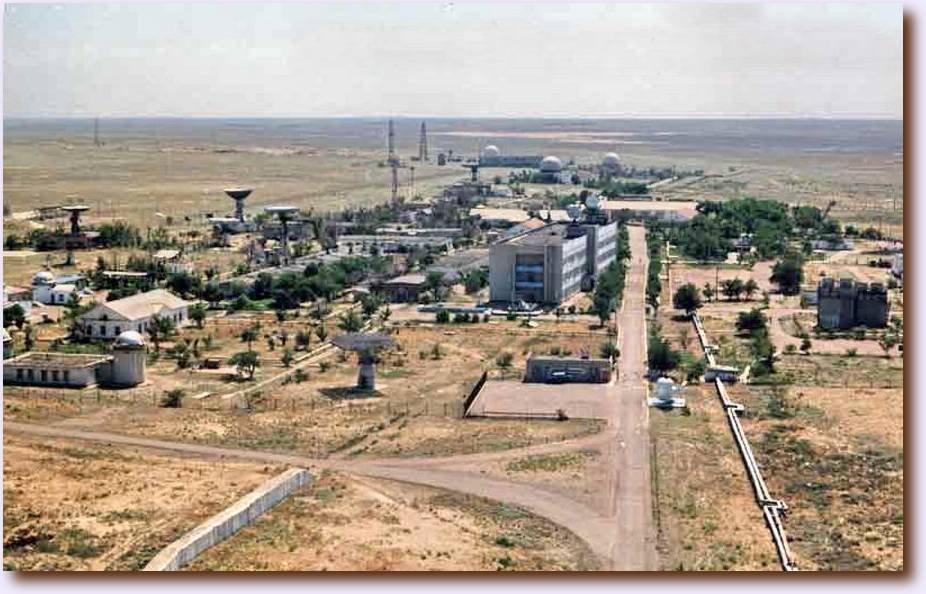
Общий вид ИП-1, фото КИК СССР
Также в Москве работал сочетающий в себе функции вычислительного центра и центра управлением полетами КВЦ при НИИ-4.

Здание НИИ-4, фото КИК СССР
КВЦ вычислял параметры орбиты, формировал команды для передачи на корабль и целеуказание для наземных средств — куда и когда повернуть антенну, чтобы связаться с кораблем. Внутренняя организация помещений была настолько секретной, что на фото и видео сейчас можно найти разве что имитацию для фильмов.

Так могла выглядеть работа КВЦ. Фото РИА Новости/КИК СССР
Тот ЦУП, который мы знаем сейчас как ЦУП-Москвы, появился в 1973-75 на базе КВЦ. В принципе, никто не мешал отразить эту специфику в фильме.
Немного астрономии
В фильме есть забавный астрономический ляп — в одном кадре Луна полная, в другом — видна только половина диска. То есть Беляев и Леонов по фазам Луны летали бы неделю. Если посмотреть реальную фазу Луны в момент полета, то прав первый вариант — «Восход-2» запустили в районе полнолуния.
Характеры и атмосфера
Характеры космонавтов получились, на мой взгляд, практически карикатурными. Леонов постоянно нарушает все возможные правила, и ему все сходит с рук. А Беляев показан настолько выраженным меланхоликом, что удивляешься, как его вообще взяли в космонавты.
Поразительно, но, несмотря на то, что фильм героический и пафосный, он получился мрачноватым. Кажется, что многовато саспенса и маловато светлых моментов. Даже радость в последней сцене смазана эффектом старой пленки. И финальная песня, от которой действительно наворачиваются на глаза слезы, спета медленнее и как-то печальней, чем ее пели в «Москве-Кассиопее».
Заключение
Несмотря на то, что на протяжении многих абзацев я указываю на недостатки и ляпы фильма, в целом он мне понравился, и по крайней мере один раз посмотреть его, на мой взгляд, стоит.








